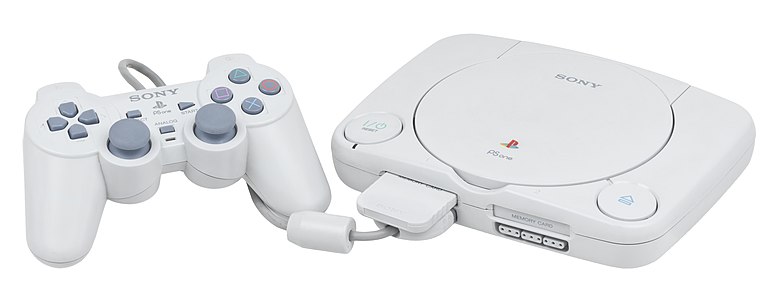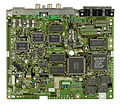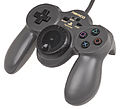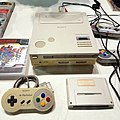History of video games/Platforms/PlayStation
-
Original PlayStation, with upgraded Dual Shock controller.
-
The smaller PSone without an LCD attached.
History
[edit | edit source]
Nintendo Partnership
[edit | edit source]The Play Station was initially a partnership between Nintendo and Sony to develop a disk based add on for the SNES.[1] The partnership fell through when Nintendo made a surprise announcement in 1991 that they were partnering with Phillips for their CD-i system instead, as they did not want to yield control over the SNES CD format to Sony.[2][3]
Development
[edit | edit source]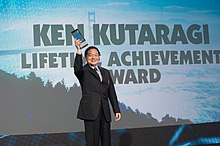
Despite litigation from Nintendo, Sony continued to develop their game console independently.[2]
Ken Kutaragi was able to keep costs low by leveraging Sony's existing semiconductor and CD-ROM factories.[4] This vertical integration gave Sony a huge cost advantage over competing hardware, which had to buy from external firms instead of an internal supply chain.[5]
The entry of Sony into the console market was initially not taken seriously by the industry.[6] However by building a solid support infrastructure for their console prior to release, Sony was able to sign a number of developers, and even get a few developers to switch their franchises entirely to their platform.[6] The PlayStation was also considered relatively easy to develop for,[7] which was a huge advantage in a market featuring a number of consoles with hard to master architectures.
Launch
[edit | edit source]
Japan
[edit | edit source]The PlayStation launched in Japan on December 3rd, 1994.[8]
North America
[edit | edit source]Sony employee Steve Race announced the cost of the PlayStation in North America at E3 1995, shortly after Sega announced the release of it's Sega Saturn at a cost of $399.[9]
$299—Steve Race, Entire speech at E3 1995.[9]
This short speech launched the room into applause,[10] as the PlayStation was significantly less expensive then competing systems.
Europe
[edit | edit source]The PlayStation was quite popular after launching in France, with a March 4th, 1997 article in Le Monde claiming 600,000 consoles were sold over the prior 18 months.[11]
Revisions
[edit | edit source]
A number of revisions were made during the production of the PlayStation, resulting in the removal of RCA ports and later on the parallel port.[12]
Net Yaroze
[edit | edit source]The Net Yaroze was launched in March of 1997 for $750 to promote independent development for the PlayStation.[13] While not comparable to the full development kit with features like a debugger missing, the system gave Indie developers the opportunity to have demos of their games included in official Demo CDs.[13][14]
Legacy
[edit | edit source]
The original PlayStation was followed by the PlayStation 2.
Manufacturing of the original PlayStation stopped in 2006.[15] The PlayStation was a massively popular console, ultimately selling over 102 million units.[2][16]
The original PlayStation had a popularity long surpassing its launch. Due to its status in the modding community as a cheap and beginner friendly console, unofficial mods for the system continued to be released as recently as 2021.[17][18]
Technology
[edit | edit source]
PS1 was the best design of its generation.—John Carmack, Tweet on February 21st, 2013.[19]
Compute
[edit | edit source]The PlayStation CPU uses a 32 bit RISCI processor derived from an LSI CoreWare CW33300 design, and is clocked at 33.87 megahertz.[20]
The PlayStation has 2 megabytes of RAM and 1 megabyte of VRAM.[21]
The PlayStation did not generate enough heat to need a fan.[22]
Graphics
[edit | edit source]The PlayStation Aesthetic
[edit | edit source]The unique technical attributes of the PlayStation lead to games developed for the system possessing a unique aesthetic. A defining aspect of this are visually sharp polygons which "wobble".[23]
Because of the relatively large storage space available on CD, many games used relatively high resolution textures. However a lack of compute resources meant that these textures were generally not very filtered or smoothed.
It's important to note the context of which the PlayStation would have been used to understand how its graphics would have actually looked to a gamer of the day. Generally game consoles of that period were played on cheap or modest consumer grade CRT televisions, which naturally had a fuzzy sort of quality and distortion to them. These imperfections and flaws thus somewhat worked to obscure console limitations. When playing original PlayStation games on superior displays, it should be noted that the result one sees is different from what would have been generally seen at the time.
Hardware
[edit | edit source]
CD Drive
[edit | edit source]The PlayStation has a 2x speed CD Drive.[24] Though the console is not the first to leverage CD-ROMs, the original PlayStation is perhaps the most iconic console to use CD-ROMs, and is often seen as the archetype of a CD-ROM Console.
Advantages
[edit | edit source]Sony was a major player in the CD-ROM industry, and the PlayStation exists precisely because of this given its origin as an SNES and Super Famicom CD-Add On. However the CD-ROM was important for more than design inertia. The use of CD technology was a major selling point of the system, for both consumers and manufacturers. This is because CD-ROMs were capable of much more storage then consumer grade cartridges of the time, allowing for more expansive games. CDs could be pressed at a lower cost for the manufacturer then the manufacture of cartridges.
Disadvantages
[edit | edit source]While the PlayStation was not the first console to use optical disks, the technology still had a long way to go. The most notable downside was speed, with many games requiring significant loading times. Despite the massive increase of capacity over cartridges, some ambitious developers required even more space than what could be offered by a CD-ROM, requiring some games to be shipped on multiple disks. Additionally, as the 1990s progressed, the proliferation of consumer CD-Burners made piracy for the system extraordinarily easy compared to cartridges.
Accessories
[edit | edit source]Memory Cards
[edit | edit source]Since the PlayStation could not burn save data to CD-ROMS[25] and game saves had become a somewhat standard feature among games, a way for users to save games was needed. This was accomplished with memory cards.
PocketStation
[edit | edit source]In Japan, the Pocketstation was released as a basic handheld console and memory card combo that could sync mobile minigames with PlayStation games.[26]
Games
[edit | edit source]
Qualities
[edit | edit source]- The original PlayStation is seen as an usurper in the JRPG field, with major publishers taking advantage of the system's enhanced storage capabilities, as well as a much lesser degree of publisher restrictions on game content to create new and innovative experiences. Many JRPGs for the original PlayStation are seen as "Killer Apps" for the system.
- Racing and sports games all did well on the original PlayStation.
- Platformers on the original PlayStation have a mixed legacy. While some of the most acclaimed platforms released on the original PlayStation, the system would also see the release of some of the most notorious platformed blunders of the genre.
- Thanks in part due to it's native CD audio capabilities, rhythm and music games did well on the system.
1995
[edit | edit source]Tekken
[edit | edit source]Read more about Tekken on Wikipedia.
Twisted Metal
[edit | edit source]Read more about Twisted Metal on Wikipedia.
Air Combat / Ace Combat
[edit | edit source]Read more about Air Combat on Wikipedia.
1996
[edit | edit source]Crash Bandicoot
[edit | edit source]The first Crash Bandicoot game.
Read more about Crash Bandicoot on Wikipedia.
Tomb Raider
[edit | edit source]Read more about Tomb Raider on Wikipedia.
Tekken 2
[edit | edit source]Read more about Tekken 2 on Wikipedia.
PaRappa the Rapper
[edit | edit source]Read more about PaRappa the Rapper on Wikipedia.
Revelations: Persona
[edit | edit source]The first of a series of games noted for loosely drawing concepts from Jungian psychology.[27]
Read more about Revelations: Persona on Wikipedia.
Resident Evil
[edit | edit source]The first Resident Evil game.
The game included some Live Action cutscenes, and despite using some cutting edge filmmaking techniques for the time, credits for the actors involved were not properly recorded, leaving only the actor's first names in the credits.[28]
The 1998 Resident Evil Director's Cut had music said to be composed by the then famous deaf composer Mamoru Samuragochi, only for it to later be revealed in 2014 that a Samuragochi used a ghostwriter,[29][30] and that Samuragochi was not fully deaf.[31] Samuragochi would later claim he actually had written the music for the Basement section of the game, and backed this up with a recorded VHS performance of him playing it on keyboard in the 1990's.[32] The music of the Directors Cut is often seen as hit or miss, depending on the individual track.[33]
Read more about Resident Evil on Wikipedia.
1997
[edit | edit source]- Gran Turismo - Best selling game on the system
- Final Fantasy VII - First 3D Final Fantasy game
- Tomb Raider II
- Crash Bandicoot 2: Cortex Strikes Back
- Final Fantasy Tactics
- Tomba! - 2.5D platformer adventure
- Moon: Remix RPG Adventure
- Mega Man Legends
Klonoa: Door to Phantomile
[edit | edit source]2.5D mascot platformer Read more about Klonoa: Door to Phantomile on Wikipedia.
Ace Combat 2
[edit | edit source]Read more about Ace Combat 2 on Wikipedia.
1998
[edit | edit source]Xenogears
[edit | edit source]Xenogears was originally supposed to be Final Fantasy 7.[34]
Read more about Xenogears on Wikipedia.
Metal Gear Solid
[edit | edit source]The first 3D game in the Metal Gear series. This game was originally a 3DO title before development shifted to the PlayStation.[35]
The game featured an advanced stealth system, accounting for events such as enemy guards tracking footprints the player left in the snow,[36] using wolf urine to mask the player scent,[35] and other innovative mechanics.
The acclaimed main theme of the game is notably similar to the earlier composition of Winter Road by the famed Russian composer Georgy Sviridov.[37][38]
Read more about Metal Gear Solid on Wikipedia, or read the WikiBook on the general Metal Gear Series.
Spyro the Dragon
[edit | edit source]The first game in the Spyro the Dragon series. This innovative 3D platformer and collectathon allowed more open movement then most other games in the genre at the time.
Read more about Spyro the Dragon on Wikipedia.
1999
[edit | edit source]- Gran Turismo 2
- Final Fantasy VIII
- Tony Hawk's Pro Skater
- Silent Hill
- Chrono Cross
- Tomba! 2: The Evil Swine Return
- Ape Escape
- Pepsiman
- The Misadventures of Tron Bonne
- 40 Winks
- Harvest Moon: Back to Nature
- Crash Team Racing
Persona 2: Innocent Sin
[edit | edit source]Despite being the older release, Innocent Sin was released in North America years after Eternal Punishment due to localization issues arising from including Adolf Hitler as a character.[39]
Read more about Persona 2: Innocent Sin on Wikipedia.
Um Jammer Lammy
[edit | edit source]The sequel to PaRappa the Rapper. The game is noted for it's guitar focused spin on the mechanics of PaRappa the Rapper.[40]
Read more about Um Jammer Lammy on Wikipedia.
Spyro 2: Ripto's Rage
[edit | edit source]The sequel to Spyro was released just a year later, and featured greater movement options, as well as more side quests.
Read more about Spyro 2: Ripto's Rage! on Wikipedia.
Ace Combat 3: Electrosphere
[edit | edit source]Read more about Ace Combat 3: Electrosphere on Wikipedia.
2000
[edit | edit source]- Final Fantasy IX
- Spyro: Year of the Dragon
- Crash Bash
- Dragon Quest VII
- Persona 2: Eternal Punishment
- Mega Man Legends 2
Vagrant Story
[edit | edit source]Vagrant Story is known for its system defying artwork, which used subtle application of pixel art and 3D tricks to create an incredibly detailed environment, especially given the limitations of the hardware.[41][42]
Read more about Vagrant Story on Wikipedia.
2001
[edit | edit source]Tear Ring Saga
[edit | edit source]A tactical role playing game developed by Shouzou Kaga, the creator of the Fire Emblem series.[43] Nintendo would later take legal action over the close similarities between this game and Fire Emblem.[44]
Read more about Tear Ring Saga on Wikipedia.
Gallery
[edit | edit source]PlayStation
[edit | edit source]PSone
[edit | edit source]PSone Internals
[edit | edit source]Controllers
[edit | edit source]Accessories
[edit | edit source]Development
[edit | edit source]Nintendo Play Station
[edit | edit source]The prototype Nintendo Play Station.
Marketing
[edit | edit source]-
PlayStation Logo
-
PlayStation console logotype.
-
PSOne logotype.
References
[edit | edit source]| Parts of this page are based on materials from: Wikipedia: the free encyclopedia. |
- ↑ Walton, Mark (9 November 2015). "The fabled SNES-PlayStation prototype has been turned on and disassembled" (in en-us). Ars Technica. https://arstechnica.com/gaming/2015/11/the-fabled-snes-playstation-prototype-has-been-turned-on-and-disassembled/. Retrieved 18 October 2020.
- ↑ a b c Walton, Mark (3 July 2015). "Fabled CD-playing, SNES-compatible "Play Station" prototype found in a box". Ars Technica. Retrieved 18 October 2020.
- ↑ Shapiro, Eben (3 June 1991). "Nintendo-Philips Deal Is a Slap at Sony (Published 1991)". The New York Times. Retrieved 17 November 2020.
- ↑ "Hideki Sato Discussing the Sega Saturn". Mega Drive Shock. 16 June 2020. Retrieved 27 October 2020.
- ↑ "Hideki Sato talks about creating SEGA Saturn hardware and Sony asking SEGA to go third party". Hideki Sato talks about creating SEGA Saturn hardware and Sony asking SEGA to go third party. Retrieved 2 January 2021.
- ↑ a b "PlayStation: How Sony came to dominate the gaming industry". Digital Innovation and Transformation. Retrieved 18 October 2020.
- ↑ "Interview - Seth Mendelsohn". www.gamezero.com. Retrieved 21 November 2020.
- ↑ "Decade of dominance for PlayStation". 3 December 2004. http://news.bbc.co.uk/2/hi/technology/4054797.stm. Retrieved 28 October 2020.
- ↑ a b "It's Been 25 Years Since Sega Shocked the Gaming World: Here's What Happened" (in en). PCMAG. https://www.pcmag.com/news/its-been-25-years-since-sega-shocked-the-gaming-world-heres-what-happened. Retrieved 26 October 2020.
- ↑ "PlayStation 25th Anniversary: How Sony created the console that redefined the game industry". Edge Magazine. Retrieved 26 October 2020.
- ↑ "Le public des consoles de jeux prend de l'âge" (in fr). Le Monde.fr. 4 March 1997. https://www.lemonde.fr/archives/article/1997/03/04/le-public-des-consoles-de-jeux-prend-de-l-age_3765876_1819218.html.
- ↑ Byford, Sam (11 July 2019). "A brief history of cutdown game consoles" (in en). The Verge. https://www.theverge.com/circuitbreaker/2019/7/11/20690011/nintendo-switch-lite-game-console-redesign-xbox-playstation. Retrieved 19 October 2020.
- ↑ a b "15 Years Later: How Sony's Net Yaroze Kickstarted Indie Console Development". Retrieved 25 November 2020.
- ↑ "Doing It Together: Remembering PlayStation's Net Yaroze Console". www.vice.com. Retrieved 25 November 2020.
- ↑ "Sony stops making original PS". GameSpot. https://www.gamespot.com/articles/sony-stops-making-original-ps/1100-6146549/. Retrieved 28 October 2020.
- ↑ "The bestselling consoles of all time". www.digitaltrends.com. Retrieved 14 November 2020.
- ↑ "VGA Without The Hassle, From Your PlayStation One". Hackaday. 12 February 2021. https://hackaday.com/2021/02/12/vga-without-the-hassle-from-your-playstation-one/.
- ↑ "Burning Your Own PS1 Modchip Is Easy". Hackaday. 1 November 2020. https://hackaday.com/2020/11/01/burning-your-own-ps1-modchip-is-easy/.
- ↑ "@ID_AA_Carmack". Twitter. https://twitter.com/ID_AA_Carmack/status/304662242627031040?.
- ↑ "PlayStation Architecture A Practical Analysis". Rodrigo's Stuff. 8 August 2019. Retrieved 29 October 2020.
- ↑ "PS1 Strengths and Weaknesses vs N64 and Sega Saturn". RetroGaming with Racketboy. 11 January 2020. Retrieved 29 October 2020.
- ↑ Gartenberg, Chaim (3 December 2019). "Remember how simple consoles used to be with this original PlayStation teardown" (in en). The Verge. https://www.theverge.com/circuitbreaker/2019/12/3/20993374/playstation-sony-ifixit-teardown-simple-hardware-internal-components-cd-drive. Retrieved 20 October 2020.
- ↑ "PlayStation 1 Graphics Wobble". RetroRGB. 26 March 2020. https://www.retrorgb.com/playstation-1-graphics-wobble.html.
- ↑ "Sony PlayStation Teardown". iFixit. 3 December 2019. Retrieved 29 October 2020.
- ↑ Note: It is sometimes possible to burn data to finished CD-ROMs with unused space, but this is unsuitable for consumer applications, and the original PlayStation lacked a CD burner, making this infeasible.
- ↑ Byford, Sam (4 December 2019). "The portable PlayStations were Sony at its most ambitious" (in en). The Verge. https://www.theverge.com/2019/12/4/20991654/psp-vita-portable-playstation-console-sony-25-anniversary. Retrieved 20 October 2020.
- ↑ Tisdale, Alex. "'Persona' Bends But Doesn't Totally Break Jungian Psychology" (in en). Inverse. https://www.inverse.com/article/22672-persona-carl-jung-psychology-matthew-fike-interview.
- ↑ "23-Year-Old Resident Evil Mystery Solved". Game Rant. 26 December 2019. https://gamerant.com/resident-evil-actor-rebecca/.
- ↑ "Noted deaf composer admits his music was ghostwritten". The Japan Times. 5 February 2014. https://www.japantimes.co.jp/news/2014/02/05/national/noted-deaf-composer-admits-someone-else-writes-his-music/.
- ↑ Yin-Poole, Wesley (5 February 2014). "Resident Evil and Onimusha composer exposed as a fraud" (in en). Eurogamer. https://www.eurogamer.net/articles/2014-02-05-resident-evil-and-onimusha-composer-exposed-as-a-fraud.
- ↑ "Japan's Fraudulent Composer Returns Years Later With New Music" (in en-us). Kotaku. https://kotaku.com/japans-fraudulent-composer-returns-years-later-with-new-1846728880.
- ↑ "Disgraced Composer Proves He Wrote Basement Theme" (in en). Dead Entertainment. https://deadentertainment.com/2018/04/27/disgraced-composer-proves-he-wrote-basement-theme/.
- ↑ Balmont, James. ""Clowns farting": The wild story behind Resident Evil's worst soundtrack" (in en). Inverse. https://www.inverse.com/gaming/resident-evil-25-composer-mamoru-samuragochi-impostor.
- ↑ "Anime and Games That Wouldn't Exist Without Neon Genesis Evangelion". IGN Southeast Asia. 5 October 2020. Retrieved 17 November 2020.
- ↑ a b "How Metal Gear Solid empowered the stealth genre". Den of Geek. 7 February 2013. https://www.denofgeek.com/games/how-metal-gear-solid-empowered-the-stealth-genre/.
- ↑ Kuchera, Ben (11 February 2021). "The 10 essential examples of snow and ice in video games" (in en). Polygon. https://www.polygon.com/essentials/2021/2/11/22268302/snow-ice-levels-games-best-worst-sonic-tomb-raider-star-wars-hoth-metal-gear.
- ↑ Alexander, Leigh. "Report: Konami Didn't Use Metal Gear Solid Theme In MGS4 Due To Plagiarism Accusations" (in en). www.gamasutra.com. https://www.gamasutra.com/php-bin/news_index.php?story=21513.
- ↑ Square, Push (9 November 2015). "Ever Wonder Why the Classic Metal Gear Solid Theme Isn't in the Phantom Pain?". Push Square. https://www.pushsquare.com/news/2015/11/ever_wonder_why_the_classic_metal_gear_solid_theme_isnt_in_the_phantom_pain.
- ↑ Hilliard, Kyle. "Learn How Hitler's Cameo In Persona 2: Innocent Sin Complicated Localization For North America" (in en). Game Informer. https://www.gameinformer.com/b/news/archive/2015/08/23/learn-how-hitler-39-s-cameo-in-persona-2-innocent-sin-complicated-localization-for-north-america.aspx.
- ↑ "10 Rare PS1 Classics On The Older PlayStation Store You Need To Buy Before It Closes". TheGamer. 3 April 2021. https://www.thegamer.com/best-ps1-classics-playstation-store/.
- ↑ Lee, Richmond (6 December 2019). "The Forgotten Pixel Art Masterpieces of the PlayStation 1 Era" (in en). Medium. https://onezero.medium.com/the-forgotten-pixel-art-masterpieces-of-the-playstation-1-era-8b453dfe00bf.
- ↑ Yin-Poole, Wesley (10 February 2020). "Vagrant Story, one of the greatest JRPGs ever, turns 20" (in en). Eurogamer. https://www.eurogamer.net/articles/2020-02-10-vagrant-story-one-of-the-greatest-jrpgs-ever-turns-20.
- ↑ "The 10 Best Fan Translation Rom Hacks Of Games Never Released In North America". TheGamer. 1 September 2020. https://www.thegamer.com/best-fan-translation-rom-hacks-games-never-released-north-america/.
- ↑ "Nintendo Sues Over Emblem Copyright - IGN" (in en). https://www.ign.com/articles/2001/07/25/nintendo-sues-over-emblem-copyright.

